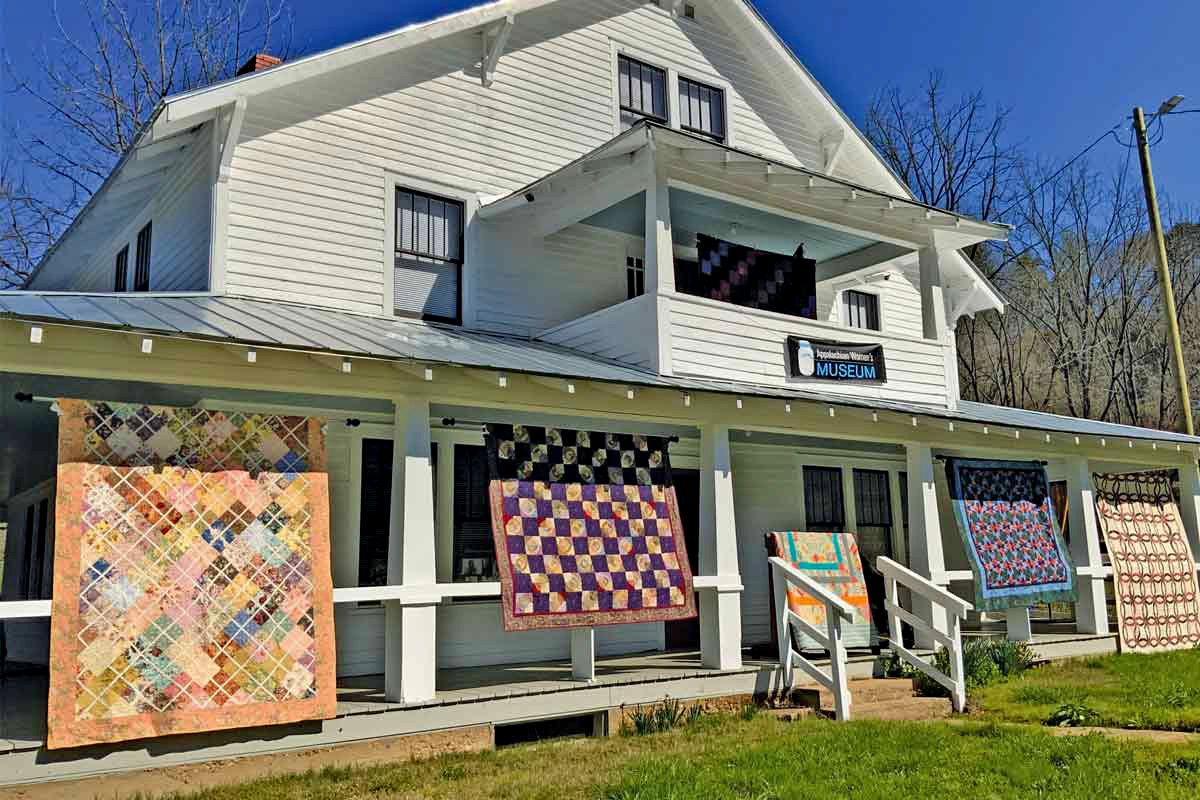Keeping it real: Waynesville ponders historic district guidelines
The town of Waynesville has hired a consultant to help create mandatory design standards for buildings in historic districts.
How the axe fell
 Talk of cutting the historic courthouse maples in Waynesville has come and gone during the years.
Talk of cutting the historic courthouse maples in Waynesville has come and gone during the years.
Reasons varied. It was hard to get grass to grow underneath. The trees masked the grandness of the historic courthouse. Heavy equipment parked under the trees during courthouse renovations damaged the root systems.
Merchants field queries over missing courthouse trees
Main Street merchants are used to answering tourists’ questions: how do you get to the parkway, what’s the best place for dinner, and where are the public restrooms? But lately, Waynesville’s downtown store keepers have also become purveyors of news.
Another one bites the dust: ax beckons to the last of the courthouse trees
The lone evergreen tree left standing on the lawn of the historic courthouse in downtown Waynesville will soon be coming down.
Waynesville begins fund drive to pay for historic arch replica
Donations are already rolling in for the Waynesville Art Commission’s latest public art piece, a replica of the historic Smokies’ arch over Main Street, but the group is still looking for donors.
“I am real pleased with the response so far,” said Jan Griffin, head of the art commission.
The art commission has already sent out its first wave of fundraising letters to many of the established local families of Waynesville and plans to mail more letters in the coming weeks. The donations will help pay for a “Gateway to the Smokies” arch, which will be installed in the mini-park at the corner of Main and Depot streets. The original arch spanned Main Street itself for several decades, proclaiming the town as the “Eastern Entrance to the Great Smoky Mountains National Park.”
So far, the commission has received about $2,000 in private donations toward a new Waynesville arch that will cost between $5,000 and $6,000.
“We are very pleased with that,” said Griffin. “The interest is very, very high. We’ve got an awful lot of really excited people about it.”
With one possible exception.
Town Manager Lee Galloway received a phone call from Bryson City Town Manager Lee Callicutt a couple of months ago regarding the wording on the arch. The piece will read “Gateway to the Smokies,” a slogan that Bryson City has used on its seal and police department badges for decades.
“He said that he had been directed to pass the concern of the Town of Bryson City on to me,” Galloway said.
Some in Bryson were less than thrilled that Waynesville’ arch would bear their catch phrase. Nothing else came of the concern.
The art commission has created and installed three permanent public art pieces around town during the past few years. The latest addition will be the archway, the second art piece referencing the Smokies in the mini-park on the corner across from the historic courthouse. Already in place is a metal railing with mountain peaks and salamanders.
The art commission premiered its artistic renderings of the arch earlier this fall.
Ed Kelley, who has headed the project, is now taking the sketches of the arch to an engineer who will act as a consultant, suggesting specifically how the arch will be made and what it will be made of.
“Everything has to be very specific,” Kelley said.
Once the parameters are set, the commission will take bids from several area artists and award the project to the lowest bidder.
People who wish to donate to help pay for the arch can write a check to the Town of Waynesville and drop it at the municipal building on Main Street. Donors should note that the money is for the art project in the memo line.
Swain courthouse slated for civic revival
After years of talk and little action, Swain County is moving forward with a long-held dream to turn its iconic, domed courthouse into a cultural history museum and visitors center.
The architectural centerpiece of town, the old courthouse has been mostly empty for three decades since court functions moved out in the 1929s, aside from housing a senior center that has since relocated.
“We’ve had this vision for a long time,” said Ken Mills, executive director of economic development.
The county has seriously discussed such a transformation since 2009, though the idea was tossed around for years prior to that. In that time, Mills has not heard a derogatory comment about the county’s plans.
“We have never had anyone say it was a bad project, a useless project,” Mills said.
The cost of renovations is estimated at $750,000. But, by using some of its own building and maintenance employees to do some of the work, the county hopes to reduce the overall price tag, Mills said.
The county has taken out a $600,000 loan for the project. Another $100,000 is being kicked in by the Great Smoky Mountains Association, which will run a bookstore in the museum. The non-profit functions as a support arm for the Great Smoky Mountains National Park, operating bookstores inside the park selling everything from guidebooks and maps to souvenirs.
The Swain County Chamber of Commerce will move at least part of its visitor center operations into the old courthouse. The chamber is not sure yet how much of its operations will move into the refinished courthouse, said Karen Wilmot, executive director of the Swain County chamber.
“We support this project. We very much look forward to this building being renovated,” she added.
Employees from the chamber and the Great Smoky Mountains Association will help man the center.
Several years ago, the county undertook a three-year planning process to identify what stories should be highlighted in such a museum. In addition to the natural and cultural heritage of Swain County, the museum will include the history of the national park, a major drawing card for tourists traveling to the region.
“The park’s history is our history,” Mills said.
The county has also reached out to the Eastern Band of Cherokee Indians to see if they would be interested in being included in the museum exhibits.
The old building, located at the corner of Everett and Main streets, will also offer people access to public restrooms, which could provide crucial for downtown event attendees throughout the year.
The blueprints
Most of the estimated project cost will pay for renovating the second floor, which needs considerably more attention than the first floor.
The entrance level was redone in the 1980s and features up-to-date fixtures and molding. One of the few original parts of the building, which was erected in the 1920s, is its outward appearance.
“We’re not really sure how much we will be able to restore,” Mills said. “But, most of the things we have saved we’re going to try to keep and somehow put back in here.”
For example, the county saved the original seating from the upstairs courtroom but was unable to restore stamped tiles that decorated the ceiling.
In simply preparing for the renovation, county workers have uncovered several hidden elements of the old courthouse. At some point in its long history, the county decided to drop the ceiling level in the courtroom, concealing a number of small windows at the top of the walls.
In the past, unfortunate souls who found themselves face-to-face with the county judge could look up, through a window in the ceiling to a still functioning bell that crowns the old courthouse. Somewhere along the way, however, the windowpanes were painted white, depriving people of the view.
The main visible changes to the first floor will include new furniture and a long wooden counter where someone will greet and aid visitors, and vignettes painted on the walls, similar to those at the new Great Smoky Mountains National Park Oconaluftee Visitors Center at the park entrance outside Cherokee.
The upstairs portion, which will serve as the museum, is quite a different story. With some missing windows, no ceiling beyond wooden beams and a concrete floor that failed the pounds-per-square-inch test, the second floor will need the most renovation.
“We are going to end up redoing this whole upstairs,” Mills said.
The upper level once served as the courtroom and could in the future include artifacts such as the shell of a log cabin, showing how the people of Swain County once lived.
Several county residents have already offered to display their family artifacts in the museum.
Once construction begins, the renovations will take two years.
“We are hoping to get started soon,” Mills said.
Mills said the new visitor center and museum will hopefully draw more people, or rather potential customers, to the town.
In addition to renovating the building, the county plans to construct a parking lot behind the building that could be accessed via Main Street. Currently, the gravel-covered lot sits empty.
Mills said he did not know how much the lot would cost, but it has not been figured into the estimated renovation costs.
The county is also looking into put a small park next to the lot, where people can just sit or have lunch.
“We are hoping to have nice green space out there,” Mills said.
WCU library sharpens focus on regional history with two new websites
Individuals with an interest in the region’s past can now search two new online archives devoted to Cherokee culture and the evolution of travel in Western North Carolina.
Both sites are maintained courtesy of Western Carolina University’s Hunter Library.
“Travel Western North Carolina” includes images and commentary about 27 towns and communities in WNC over five decades. The site allows users to follow a route along footpaths and wagon trails in the 1890s, take a train ride in the 1910s, and drive by car along mountain roads in the 1930s.
Each “stop” includes a description of the community and excerpts from primary documents of the time, including newspapers, letters and guides. The site is online at www.wcu.edu/library/DigitalCollections/TravelWNC.
“Cherokee Traditions: From the Hands of Our Elders” unites information about Cherokee basketry, pottery, woodworking and more and includes information about artisans and archival photos. The “From the Hands of Our Elders” pages grew from a grant-funded, multi-institutional project that also saw the creation of two guides to Cherokee basketry and pottery. The site is online at www.wcu.edu/library/DigitalCollections/CherokeeTraditions.
Photographs and documents from the sites are accessible by searchable databases, making rare and unique research materials accessible to students, researchers, teachers and the public. Both new collections formerly were elements within Hunter Library’s “Craft Revival: Shaping Western North Carolina Past and Present” website, a research-based site that documents an effort to revive handcraft in the western region of the state in the late 19th and early 20th centuries.
Anna Fariello, an associate research professor who headed the craft revival site’s creation and development, was responsible for generating much of the content in the “Cherokee Traditions” pages.
“I think this will be especially helpful to our students and researchers who want to look at authentic Cherokee material,” Fariello said. “The way I built this site, perhaps it could be added onto. It has the capacity to be expanded to include some of the other aspects of Cherokee culture that are focuses of WCU’s Cherokee Studies Program.”
Pages in the “Travel Western North Carolina” site – originally intended as context for the craft revival site – were created through research by George Frizzell, head of special collections, and illustrated with special collections documents. Frizzell wants visitors to the site to come away with an understanding that the WNC region changes and adapts like any other.
“I hope it shows people that this area changed with the arrival of new technologies, and that with the arrival of the railroad and automobile, the infrastructure was revised and revamped, and people acknowledged the impact on the economy,” he said.
Digitizing information serves a number of purposes, said Mark Stoffan, head of digital, access and technology services for WCU’s Hunter Library. Statistics show that the library’s digital collections are accessed by users from around the world. Increased digitization opens information to a broader audience. Digitization can help publicize collections – sometimes prompting gifts of similar materials – and helps protect originals from handling.
For more information about the new digital collections at WCU, call Fariello at 828.227-2499 or email her at This email address is being protected from spambots. You need JavaScript enabled to view it.. For a list of all Hunter Library’s digital collections, go online to www.wcu.edu/library/DigitalCollections.
Resolution long way off in Haywood’s historic courthouse quagmire
Haywood County is headed to arbitration in a lawsuit over the $8.2 million renovation to the historic courthouse.
The contractor sued the county for $2 million after being fired from the job in May 2008. The county claimed the contractor was “significantly behind schedule” and was “incapable” of finishing the job they were hired to do.
Meanwhile, KMD Construction claims it was working off inaccurate blueprints. As a result, the project took a lot longer than expected, and was more expensive.
The county refused to pay for cost overruns, however. KMD says it was left holding the bag and wants the county to pay up. The suit cites wrongful termination by the county and negligence by the county’s architect.
Last week, the county learned arbitration to settle the ongoing dispute has been scheduled for May 2011.
The county and contractor butted heads for most of the project, but the final straw came when the county learned the contractor was cutting corners that compromised the structural integrity of the building, according to court filings. Specifically, a cinder-block wall of an interior staircase at the rear of the courthouse was being put up without proper internal support.
“KMD management was aware of the unsafe, improper and defective construction and intended to cover it up,” the county claims in court filings, defending its firing of KMD.
Another construction error involved leaky conduit for electrical lines feeding an emergency generator. The conduit was not properly sealed, and leaks damaged the switch for the emergency power supply, according to the county.
In yet another mishap, kerosene heaters were left burning unattended to make drywall mud dry faster. One malfunctioned and smoke and soot got into the ventilation system and filled the building.
KMD, however, says the architectural plans were inadequate and failed to meet building code, leaving out key support beams in several places.
The construction plans also failed to reflect the condition of the historic building, such as the varying thickness of the stone exterior walls and undulating slopes in the floor, which required extensive leveling, KMD claims in its suit.
The county admits that the blueprints weren’t perfect, but that goes with the territory when making renovations to a historic 1930s-era building.
“Haywood County admits that the project designs required revisions through the course of construction to meet unknown conditions in the existing building,” wrote Bob Meynardie, an attorney representing the county, in court filings.
The county countersued the contractor, claiming it racked up additional expenses of its own during the drawn-out project. It had to pay rent on satellite office space during the renovations, pay architects for additional time and hire a scheduling consultant to keep the project on task.
The county withheld payments from the contractor to cover most of the extra costs it incurred as a result of the quagmire, while other costs were picked up by a surety bond taken out by the county as insurance against just such a scenario. As a result, the county didn’t pay any more for the project than it had budgeted originally. It was completed a year late, however.
What now?
Arbitration will bring a final resolution to the dispute and is similar to a court trial.
“The contractor will present their case, we will present our case and the arbitrators will decide whether or not to make an award to either side,” said Meynardie.
Both sides will present evidence, call witnesses and put on exhibits.
The only difference is that arbitration isn’t held before a judge. Instead, the decision rests with a three-person panel selected jointly by both sides: one chosen by the county, one by the contractor, and the third chosen jointly by the first two. The American Arbitration Association certifies architects, engineers, contractors and lawyers to serve as arbitrators. In this case, the panel will be comprised of three construction lawyers.
The architect and engineer for the project are named by KMD in the suit as well, but the county will hold the primary burden of countering KMD’s claims.
It does not appear that the county will try to point the finger at the architects and engineers in order to absolve itself.
“We believe the contractor had more responsibility for what wrong out there than anybody,” Meynardie said.
Issues with the contractor’s work were brought to the county’s attention by the architect. The architect also recommended firing KMD. But the county stands behind its decision.
“The contractor didn’t live up to its contractual obligation. We had to make our own assessment of that,” Meynardie said.
Even if the county prevails at arbitration, it will still be out the legal costs of defending itself, Meynardie said.
Efforts to preserve Waynesville neighborhood underway
Waynesville is attempting to preserve the neighborhood bounded by Walnut and North Main streets by seeking official recognition from the National Register of Historic Places.
The town recently received a grant through the Certified Local Government Program to prepare a National Register nomination for the district.
If town officials succeed, the “Spread Out Historic District” would join the Main Street and Frog Level historic districts, which already enjoy National Register status.
“We’d hate some of these older homes be torn down,” said Bette Sprecher, a member of the Waynesville Historic Preservation Commission. “We just wanted to preserve the whole area. All the things that have been torn down through the years, you gotta preserve something.”
Sprecher has been interested in historic preservation ever since her own home on Haywood Street was supplanted by the post office in the 1960s.
“It was a beautiful house. My grandfather picked out every piece of lumber in there,” said Sprecher. “We want to avoid things like that.”
Before the Spread Out Historic District can receive official recognition, however, a study must be conducted to see whether National Register status would be justified. Property owners must also decide where they stand.
Until now, there’s been a mixed reaction, according to Sprecher. Some property owners are “all for it,” while others want their homes to be left alone.
According to the North Carolina Historic Preservation Office, however, being on the National Register doesn’t mean private property owners need permission from the federal government to make changes. Homeowners in the district can freely make alterations to the property as long as they use their own money.
The National Register status does make certain tax credits and grants available to property owners who undertake maintenance projects — whenever federal funding is available.
“The last caveat is obviously an issue right now,” said Paul Loether, National Register chief.
Homeowners must follow federal standards only if they receive this federal assistance.
Being listed on the National Register also helps local, state and federal governments in their planning processes. For example, government will make their best efforts to avoid highway construction in historic districts.
Moreover, conferring National Register status to a district is a way of honoring its past.
“It’s honorific,” said Loether. “It’s a legal recognition that a property is historic …. It’s not so much to control it, but to prevent something being destroyed that the folks in the town and neighborhood have worked so hard to preserve.”
What do you think?
A public meeting will be held at 6 p.m. on Wednesday, Sept. 15, at Waynesville town hall. Town officials will provide an overview of the Spread Out Historic District nomination and explain the National Register program to residents.
Rallying around a historic tree
Against all odds, a 250-year-old scarlet oak tree still stands on N.C. 110 south of Canton, despite being struck by lightning, despite neighboring a busy road, despite being forgotten by many for more than three decades.
A Native American council existed near the Osborne Boundary Oak, and Gen. Griffith Rutherford and his men marched by the tree while battling Native Americans nearby. The tree is documented to have served as a line marker in the late 1700s.
It remained in public memory long after.
In 1976, hundreds of local activists rallied to save the oak after the North Carolina Department of Transportation announced it would fell the tree in its quest to widen N.C. 110. Public opposition was so strong that DOT moved the highway to rescue the tree in 1978. It even put up a guardrail to protect the historic oak.
After so much energy was invested into preserving the Osborne Boundary Oak, it now lives unrecognized and undistinguished, trimmed and hacked haphazardly like any other tree by the DOT.
This year, Doris Hammett, one of the original protesters against the DOT in the ‘70s, decided it was time to take up the cause once again.
Hammett’s husband spent his last days near the tree at Silver Bluff Village, an assisted living facility in Canton. She visited him daily and would pass the diseased tree each time she went. Hammett knew she had to take action.
“In the ‘70s, the tree had a full canopy of leaves ... It was a healthy tree,” Hammett said. “When I went back, the tree has rotten limbs, it’s diseased, it’s been hacked.”
Hammett contacted the DOT, the Haywood County manager, a state senator, two historical societies, Haywood Community College’s Forestry Department — everyone she could think of who might help.
The DOT was caught completely off-guard by Hammett’s call. Changing of the guard at the agency meant knowledge of the oak had gradually been lost as officials retired.
Lloyd Anderson of Southern Tree Care, along with Doris, her daughter, DOT representatives, and historical society members, recently visited the oak to see if any hope remained for the badly damaged tree.
After a close inspection, Anderson said the tree had suffered significant root loss due to road construction, been injured by salt flying off the highway in the wintertime, and had survived being struck by lightning in the last five years.
Despite all that, Anderson concluded that with proper care, the tree could be rehabilitated and survive for another 50 years.
“It’s a tough, old tree,” Anderson said. “Everything that’s been done to it, especially after it’s been struck by lightning, it definitely has a vigor and life to it.”
Richard Queen, roadside environmental engineer at the DOT, said since learning of the oak and seeing it face-to-face, he, too, would like to see the tree saved.
Queen said the DOT would take care of the tree and bring it back to life, though the agency’s first concern will always be public safety.
“We always have to consider the liabilities of a limb falling on someone as they drive by,” Queen said.
Hammet is confident the DOT will once again take action to save the tree, but regardless of the help it has pledged, Hammett is not taking any chances on the tree this time around. She hopes to raise awareness of the Osborne Oak and other historic trees in the area to ensure they are remembered and flourish for as long as possible.
The Bethel Rural Organization is working to get the Osborne Boundary Oak on the America’s Historic Tree Register, while Hammett has convinced Haywood Community College to have its students study the tree each year to observe its growth.
With Arbor Day coming up April 30, Hammett and her daughter, Karen, hope the community will not only plant new trees but also recognize the special trees we already have.
“We have very little of the old growth forest left,” said Karen Hammett. “Old remaining giants show us what the forest was originally like before settlers came here.”
Recognized ‘Tree Cities’ in WNC
Waynesville, Sylva, Asheville and Brevard were recognized by the nonprofit Arbor Day Foundation as a Tree City USA community for their commitment to urban forestry.
Waynesville was one of only 20 towns in the state to also receive a Tree City USA Growth Award for demonstrating progress in its community forestry program recycling. The prestigious Growth Award honors environmental improvement and higher levels of tree care in Tree City USA communities.
Tree City USA communities must have a tree board or department, a tree care ordinance, a comprehensive community forestry program, and an Arbor Day observance and proclamation.
More information about Tree City USA can be found at www.arborday.org/TreeCityUSA.
Not every tree planting is beneficial
Planting a tree this Arbor Day, April 30? Waynesville town horticulturist Jonathan Yates hopes it’ll be the “right tree for the right place.”
Yates bemoans that many trees in town are mutilated each year to keep from touching utility lines overhead. He would rather see the trees cut down and have shorter trees planted, which would save homeowners from investing money in yearly maintenance, Yates said.
Waynesville has a list of trees that are appropriate for each neighborhood. Contact Yates at 828.456.3507 for more information.






















